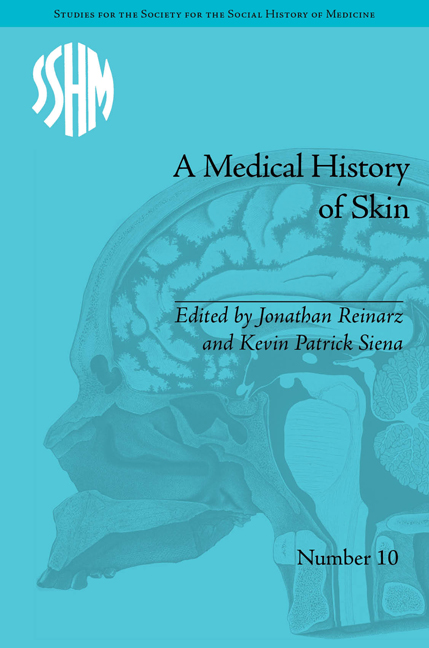Book contents
- Frontmatter
- CONTENTS
- List of Contributors
- List of Figures and Tables
- Scratching the Surface: An Introduction
- Part I The Emerging Skin Field
- Part II Skin, Stigma and Identity
- Part III Skin, Disease and Visual Culture
- Afterword: Reading the Skin, Discerning the Landscape: A Geo-historical Perspective of our Human Surface
- Notes
- Index
Scratching the Surface: An Introduction
- Frontmatter
- CONTENTS
- List of Contributors
- List of Figures and Tables
- Scratching the Surface: An Introduction
- Part I The Emerging Skin Field
- Part II Skin, Stigma and Identity
- Part III Skin, Disease and Visual Culture
- Afterword: Reading the Skin, Discerning the Landscape: A Geo-historical Perspective of our Human Surface
- Notes
- Index
Summary
On 5 December 1739 in London, Elizabeth Bradshaw stood trial for killing her tenant, greengrocer Richard Challenger, who was behind with the rent. Witnesses testified that on the night of 10 November, Bradshaw refused to let him enter. In spite of his plea – ‘I can't give it you To-night, but if you'll stay till Morning, when I have sold my Greens, by G-d you shall have it’ – she shoved him down the stairs. He tumbled into the street, hit his head and died the next day. Despite numerous witnesses and claims to Challenger's previous good health, Bradshaw walked free.
Something spoke more forcefully in the courtroom that day: Challenger's skin. A witness seeing his body washed for burial exclaimed with revulsion: ‘how they can touch him, he's all over Scabs and Sores’. John Row, the surgeon who examined the body for the coroner, drew further attention to his skin. He believed Challenger's head wound was insignificant because his skin was only abraded. ‘There was no Contusion through the Flesh – only through the Skin, or in the Way of rubbing, as by a Brick.’ Instead of head trauma, Challenger's skin suggested a different cause of death. Row's final words close the trial record: ‘there were Blotches all over his Body, through the Instigation of the Venereal Disease. Acquitted’. Challenger's blemished skin provided the most critical evidence of the day.
This admittedly dramatic example points towards the historical importance of reading the skin. While not all instances of interpreting skin lesions had life and death hanging in the balance, the following studies suggest that medical interpretations of the skin have never been disinvested of enormous and complex meaning.
- Type
- Chapter
- Information
- A Medical History of SkinScratching the Surface, pp. 1 - 16Publisher: Pickering & ChattoFirst published in: 2014



